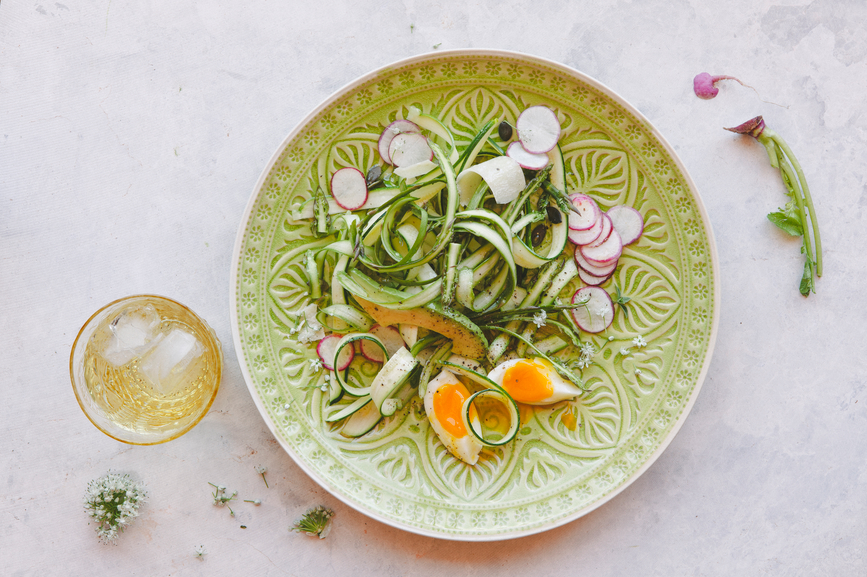“Inulin is a type of fiber found more in plants like Jerusalem artichoke and chicory root, and it can act as a prebiotic as it [can be] easily fermented by the bacteria that live in our gut,” says Amanda Sauceda, MS, RD, a registered dietitian and gut health nutritionist. “As a result of that fermentation, short chain fatty acids are produced, which can lead to positive changes in the gut microbiome.” Short chain fatty acids have a variety of positive effects on the gutthe main ones being protection against inflammation, mucus production and maintenance of the integrity of the intestinal barrier.
The positive changes in the gut microbiome can be attributed to the prebiotic nature of inulin, which can feed bacteria in our gut that can produce butyrate, a form of postbiotics that helps maintain a healthy gut, adds Sauceda. A 2017 Comprehensive Review also notes that inulin is associated with improved gut microbiota, increased mineral absorption, stimulation of immune functions, reduced risks of irritable bowel disease and constipation. There has been some research on how consuming inulin can help with other health issues like type 2 diabetes and high blood sugar, but Sauceda says the research isn’t necessarily there yet to validate those claims.
What experts do know is that inulin can help maintain a healthy gut, which can support our general well-being. It’s important to note that inulin is high in FODMAPs, which are short-chain carbohydrates that can cause intestinal upset, so this type of fiber may not be to everyone’s taste. “If you’re sensitive to FODMAPs or have irritable bowel syndrome (IBS), then you may experience bloating, gas, and general discomfort from consuming inulin-rich foods or inulin supplements, so check with a doctor beforehand,” Sauceda says. .
There is currently no Recommended Daily Allowance (RDA) for inulin, but the Academy of Nutrition and Dietetics recommends eating about 14 grams of fiber per 1,000 calories consumed per day.
8 foods rich in inulin that can help in intestinal health
Getting more inulin through your diet can be a great way to naturally support gut health and reap the gut-boosting benefits of this fiber. Sauceda shares eight great sources of inulin per 100 grams (or 3.5 ounces).
1. Chicory root: 41.6 grams
Chicory root offers the largest source of inulin and can be used as alternative to coffee or in salads. Similar to dandelion leaves, it is naturally bitter, but you can soften the flavor by soaking the root in water or by sautéing it.
2. Jerusalem artichokes: 18 grams
Jerusalem artichokes can be cooked in a similar way to red potatoes: they can be roasted, sautéed, or mashed. The white flesh of Jerusalem artichokes has a nutty yet sweet flavor that makes it easy to add to your favorite dishes.
3. Dandelion leaves: 13.5 grams
“Dandelion leaves can be sautéed, used in herbal teas, and sometimes added to pesto,” says Sauceda. Dandelion leaves are also a great source of important vitamins and minerals such as vitamin A, vitamin C, vitamin K, folic acid, calcium and potassium. But they do have a strong flavor (similar to arugula), so feel free to experiment with a cooking method that works best for your palate.
4. Garlic: 12.5 grams
If you regularly cook with garlic in your meals, then you are already unknowingly adding inulin-rich foods to your meals. Garlic not only adds great flavor to dishes, but it can also promote the growth of bifidobacteria, which are considered good bacteria in the gut.
5. Leeks: 6.5 grams
Leeks are a great source of inulin, as well as important vitamins and minerals such as vitamins B6, vitamin K, vitamin C, copper, iron, and manganese. Often considered the brother of onions, leeks offer a sweeter, milder flavor that can be added to a variety of dishes. You can add leeks to pizzas, stews, and soups. Keep in mind that leeks may require a thorough cleaning before eating, as their outer roots and leaves may have hidden dirt.
6. Asparagus: 2.5 grams
Asparagus is an example of a prebiotic-rich food that contains inulin and can also help in the production of postbiotics. While the inulin components in asparagus are a little lower than some of the other foods on this list, it’s still a great vegetable to cook with that offers tons of gut-boosting benefits.
7. Wheat bran: 2.5 grams
“Wheat bran can be used for battering chicken or for baking, depending on your preferences,” says Sauceda. “It’s also available as an eat-as-is cereal, which can serve as a high-fiber breakfast.” Whole grains generally offer tons of essential nutrients in addition to inulin, such as B vitamins, iron, copper, zinc, magnesium, antioxidants and phytochemicals.
8. Bananas: 0.5 grams
Bananas do not offer the highest amount of inulin per 100 grams, but they are a super versatile fruit that is not only delicious, but also offers vitamin C, vitamin B6, magnesium and potassium.
Final Notes on Inulin
“Inulin is definitely a good fiber to add [to your diet]especially if you struggle to meet your recommended fiber intake, but know that not eating inulin doesn’t necessarily negatively affect your gut health,” says Sauceda. If you enjoy any of the foods listed, that’s great! However, if you don’t, then Sauceda recommends finding other sources of fiber or prebiotic-rich foods that you enjoy.
On the cooking front, Sauceda also recommends having a recipe ready if you’re cooking with a new ingredient, like one of the foods listed above. “Pick one, then find a recipe to make with it so it doesn’t sit in the kitchen,” she says. You’re not sure where to start? Explore our delicious list of healthy recipes to try.
